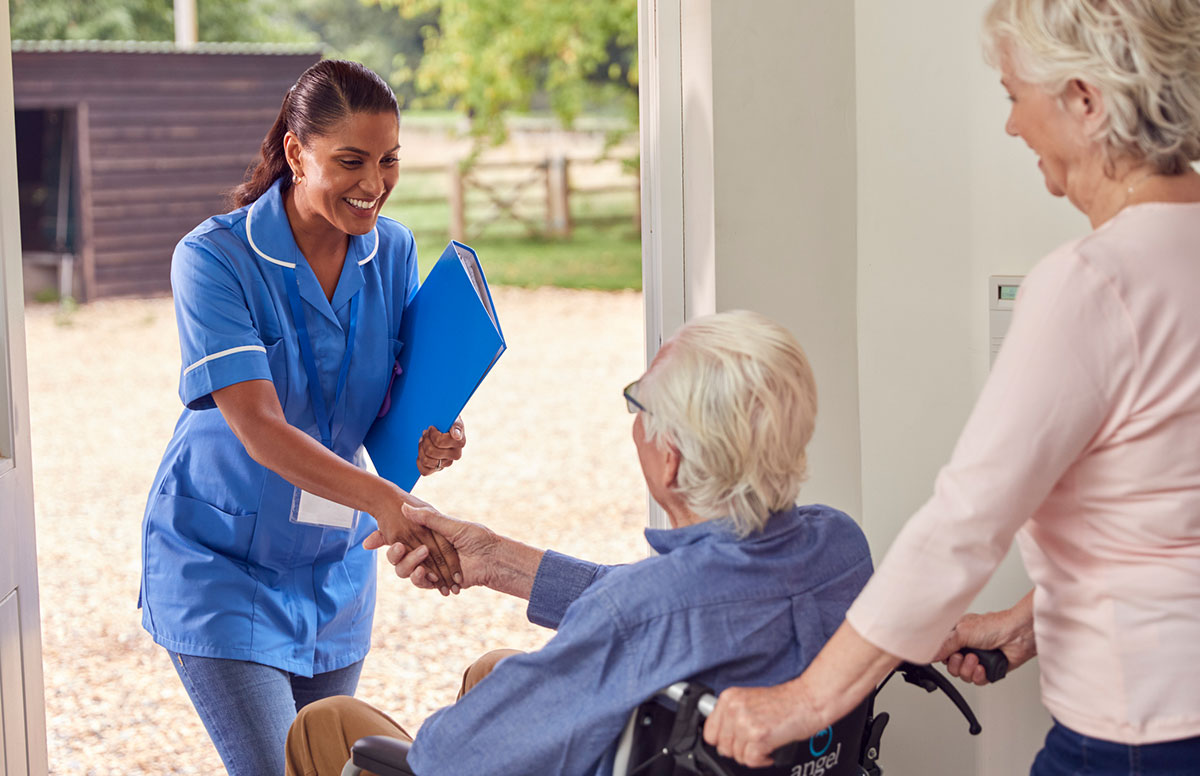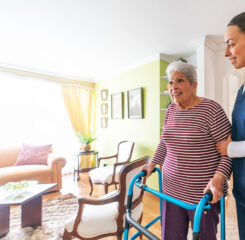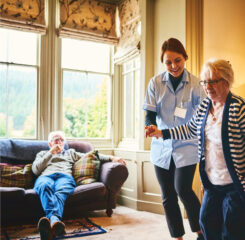Reopening to Visitors: A Review of CMS and States’ Guidance to Nursing Homes
On March 13, CMS issued a memo that drastically changed the way nursing homes operated. In response to the growing COVID-19 pandemic, CMS directed nursing homes to restrict all visitors to the nursing home, including non-essential visiting healthcare workers, “except for certain compassionate care situations.” CMS went on to further direct nursing homes to cancel all communal dining and group activities.
The reopening recommendations released on May 18 presented a framework on which state officials could rely in planning how nursing homes within the state might ease restrictions as states progress through White House Guidelines for Opening Up America Again. CMS’s recommendations include a 3-phase plan, which we have outlined here. Nursing homes must consider a number of factors, including case status within the nursing home and surrounding community, personal protective equipment and supplies, and capacity for COVID-19 testing.
Dining
Understanding the important interplay of socialization and nutritional intake, CMS emphasizes that while communal dining should be restricted while the nursing home observes the highest level of risk mitigation, residents without a confirmed COIVD-19 diagnosis and who are showing no signs or symptoms of respiratory infection are permitted to eat in the dining room, provided they are seated at separate tables and spaced at least 6 feet apart (CMS memo QSO-20-28-NH).
As nursing homes progress through reopening, communal dining is still limited to COVID-negative or asymptomatic residents only, but residents may eat with limited numbers at a table and tables spaced at least 6 feet apart. This recommendation remains in place without change throughout the reopening phases.
Activities
As the surrounding community enters phase I of Opening Up America Again, CMS states that group activities remain restricted, but nursing homes may allow some activities with social distancing, hand hygiene, and the use of cloth face coverings. Activities are restricted to those residents who are COVID-negative or asymptomatic.
Group activities and outings may resume in phase 2 for COVID-negative or asymptomatic residents. Residents must practice source control measures including social distancing, hand hygiene, and cloth face coverings, and groups are limited to no more than 10 individuals. These recommendations remain in place for phase 3, with the exception that group size for activities and outings is now limited only by the number of individuals with which social distancing can safely be maintained.
Visitation
Perhaps most highly anticipated is the reintegration of visitation. Visitation remains restricted to compassionate care situations only until the nursing home enters phase 3 of reopening. In phase 3, the nursing home may permit visitation with added precautions. All visitors must be screened and visitors with a temperature or other signs or symptoms of illness will not be permitted entry. Visitors who are permitted entry must practice social distancing and hand hygiene and are required to wear a cloth face covering for the duration of the visit.
States’ Guidance: Visitation
As of this writing, 39 states or jurisdictions have issued “reopening” guidance for Nursing Homes; the majority of these focus on the processes by which nursing homes should resume visitation (by family members and others) on campus. Below, we briefly summarize what these states have commonly recommended, and highlight a few key differences in their guidance. Notably, Ohio had rescinded their June 5th revised visitation guidance for Nursing Homes on July 2, 2020; they have since reinstated visitation guidance as of July 28, 2020.
The States/ jurisdictions that have issued visitation guidance to Long Term Care Facilities include (as of this writing) are: Arkansas, California, Colorado, Connecticut, Delaware, District of Columbia, Georgia, Idaho, Illinois, Indiana, Iowa, Kansas, Kentucky, Maine, Maryland, Massachusetts, Minnesota, Missouri, Montana, New Hampshire, New Jersey, New Mexico, New York, North Dakota, Nebraska, Ohio, Oklahoma, Oregon, Pennsylvania, Rhode Island, South Carolina, South Dakota, Tennessee, Texas, Vermont, Virginia, Washington, West Virginia, and Wyoming.
Twelve states – California, Delaware, Iowa, Kansas, Oklahoma, Maryland, Missouri, Montana, Nebraska, Pennsylvania, Virginia and West Virginia – almost adopted, nearly verbatim, the CMS reopening recommendations discussed above. The other states have created their own sets of guidelines, based on CMS and CDC’s guidance. While there are a few exceptions, these states are commonly requiring and/ or recommending the following:
- Outdoor Visits Only: With eleven exceptions, states are “reopening” visitation to nursing homes in outdoor settings only. Parameters around such settings include ensuring that residents can safely travel to and from a designated outdoor setting, that the setting is protected from weather, sun exposure, and temperature changes, and that the setting is disinfected with cleaners that kill the coronavirus, inbetween visits.
- COVID-19 Requirements: The majority of states listed in this article will only allow the resumption of visitation provided that the community has no new cases of COVID-19, and provided that the residents and visitors who are participating have not tested positive for COVID-19 and are not showing any symptoms of COVID-19.
- Visitor Requirements: Each state’s guidance delineates specific criteria that visitors must meet in order to visit a family member in assisted living. These include:
-
- The visitor must be screened and symptom-checked for exposure to and/or symptoms of COVID-19.
- Visitors are limited in number (typically 2 or fewer) and visits must be scheduled in advance with the facility;
- Visitors should wear PPE and practice the universal COVID-19 precautions as put forth by CDC (washing hands, maintaining a 6 foot distance, avoiding physical contact);
- Some states restrict visitors by age (12 or older); others permit children to visit under supervision of parents, provided they abide by the other visitor requirements.
- Resident Requirements:
- Residents should be screened prior to the visit to ensure they are not exhibiting symptoms of COVID-19. (One state, Tennessee, does provide exceptions to permit visitors in the event the resident has symptoms.)
- Residents should wear a mask, if tolerated, for the duration of the visit.
- Facility Requirements: States are requiring several key steps from the facility in order to resume on-campus, outdoor visitation:
- The facility shuld set up and manage a schedule for visitation; some states, such as Massachusetts, permit the facility to limit the number of visits, and days of the visits, depending on facility needs and staffing capacity.
- The facility should assign staff members who have been trained in COVID-19 infection control and prevention to assist residents to and from the designated visitation space, and should remain present to observe the visit while providing space for confidentiality;
- The facility should provide the space, PPE, and alcohol-based hand rub for residents and visitors to use during the visit;
- The facility should thoroughly disinfect the space used for visits between scheduled visits, and should ensure good airflow and accessibility.
- Visitors should be able to access the outdoor visitation space without having to enter any indoor areas of the facility.
Notable Exceptions: The following states have a notable exception to the common steps most of these states/jurisdictions are taking to allow visits on campus.
o Visitation Interdisciplinary Management Team: New York’s visitation guidance requires the assembly of this team to oversee and implement visitation protocols; notably, New York also requires that no more than 10% of facility residents may have visitors at any given time.
o No Food or Drink: Several states that have recently issued guidance – Arkansas, Texas, and Connecticut – explicitly restrict the consumption or exchange of food or drink between the visitor and resident. This is to make sure people do not remove their masks or face guards during the visit.
o Closed-Window Visits ONLY: Uniquely, South Carolina’s guidance only permits visitors to spend time with family via closed window visits; the guidance outlines specifics on how this is to be implemented and maintained.
o Visitor Management Tools: Arkansas, Connecticut, Kentucky and Vermont have included a few key, nuanced visitor management items in their guidance; these include:
§ Visitor Screening Questionnaire: Arkansas requires an extensive Visitor Screening Questionnaire be used with all visitors; it includes that the visitor must sign a declaration regarding their knowledge of COVID 19, visit protocol, and an agreement to inform the facility if they have any symptoms within 72 hours following the visit.
§ Visitor/ Family Letter from Ombudsman: In support of residents, families and providers, Connecticut’s Departments of Aging and Disability Services and Public Health put out this very helpful letter to all stakeholders that frames the visitation experience for all.
§ Visitor Acknowledgement Form: Kentucky suggests that providers have visitors sign this form; the form asks the visitor to acknowledge receipt of and their agreement to comply with state and facility visitation policies.
§ Masks, Gifts, and Noncompliance: Vermont’s guidance states that facility’s should require visitors to provide their own masks, that the direct exchange of items between the visitor and resident should not be allowed, and that any visitor “unable or unwilling to comply” with the visitation protocol be suspended from visiting the facility, pending more education and demonstrated compliance. (Note: Maine’s guidance on gifts, below, differs categorically from Vermont’s.)
-
- Post-Visit Monitoring: Several states’ guidance, including California, Kentucky, New Hampshire, Maine, Rhode Island, and Vermont also specifies that the facility should follow up with visitors and residents, post-visit, to check to see if either party begins to show symptoms of COVID-19 following the visit. Vermont’s guidance specifies that the visitor log should track date and time of visits, as well as the visitors’ contact information.
- Disinfecting Items in Spaces: Delaware and Kentucky’s guidance specifically references the need to disinfect any items present in the visitation space in between visits.
-
- Prioritization of Residents: In recognition of the effects of social isolation, Pennsylvania’s guidance asks providers to prioritize residents who demonstrate cognitive decline or symptoms of depression and loneliness.
- Disinfecting Items in Spaces: Delaware’s guidance specifically references the need to disinfect any items present in the visitation space in between visits.
-
- Requirements for Outdoor/ Indoor Visits: Indiana’s guidance issues requirements t Long Term Care providers (which includes AL) that outdoor visits must be available by July 4, and that a minimum number of hours of visits, both indoors and outdoors, be provided by July 17.
-
- “Tent” and Closure Guidelines: Rhode Island’s guidance offers detail on managing tents for outdoor visitation space, and also provides “closure plan” parameters if the community must rescind visitation permissions due to increased COVID 19 spread.
-
- Social Distancing Calculator: Colorado’s guidance stands out for three reasons; one interesting tool offered by the state is a “Social Distancing Calculator” that providers can use to estimate how many visitors may be in an outdoor space at a given time. Additionally, Colorado’s guidance is extended to all aging services congregate living settings – including Independent Living.
- Detailed Visitor Handling Guidance: In greater detail than most other states, Colorado’s guidance is more explicit on information that is to be gathered in visitors, as well as education that should be provided to visitors and that visitors should be escorted to and from the designated outdoor meeting space.
-
- Written Visitor Protocols: Idaho’s “Stage 4 Protocols for Long-Term Care Facilities” has explicit requirements for written visitor protocols, including, for example, that visitors be taught and demonstrate hand hygiene; the maintenance of a visitor tracking log; and that and visitors who are unwilling to comply with visit protocols be denied entry to the nursing Hhome.
- Ingress and Egress: To promote infection control, Illinois requires that the outdoor spaces used for nursing home visitation have a separately designated entrance (ingress) and exit (egress).
- Types of Face Coverings Required: Massachusetts requires specific face coverings for the staff, visitors, and residents involved in the nursing home visitation process: “Staff and residents must wear a surgical face mask and visitors must wear a face covering or mask for the duration of the visit.”
- Gifts from Visitors: In Maine’s guidance, the exchange of gifts, food and other items is discussed. Specifically, visitors are permitted to give residents a gift of food or another item, as “current data suggest that COVID-19 is primarily spread by person-to-person transmission and risk from objects is low.”
- Essential Family Caregivers. Indiana’s visitation guidance limits visitors to “Essential Family Caregivers” only. Indiana has defined this designation in this way, “Recognizing the critical role family members and other outside caregivers (e.g., friends, volunteers, private personal caregivers) often have in the care and support of residents, we recommend LTCFs consider designating as Essential Family Caregivers (EFCs) those family members and other outside caregivers, who prior to visitor restrictions, were regularly engaged with the resident at least two or more times per week in providing companionship and/or assisting with activities requiring one-on-one direction.”
The novel coronavirus pandemic is an ever-evolving and challenging threat to all our member communities, and the care and safety of residents and the people we serve must come first. As new information is made available or best practices change, LeadingAge will continue to keep you up to date. If you have questions or comments on this issue, please reach out to us at covid@leadingage.org

Most Recommended
October 15, 2025
 Shutdown Week Three: Impact of Ongoing Closure on Affordable Housing
Shutdown Week Three: Impact of Ongoing Closure on Affordable Housing
December 10, 2025
Fiscal Year (FY) Funding 2026
October 07, 2025
Immigrant Workforce Matching Program Brings Workforce Relief
Recently Added
December 29, 2025
 RHT Program Awards: All 50 States To Receive Funds, Says CMS
RHT Program Awards: All 50 States To Receive Funds, Says CMS
December 29, 2025
 CMS Publishes Draft OASIS-E2 Guidance Manual
CMS Publishes Draft OASIS-E2 Guidance Manual
December 23, 2025
 CMS Debuts Models: ACCESS, ELEVATE and LEAD
CMS Debuts Models: ACCESS, ELEVATE and LEAD
December 22, 2025



